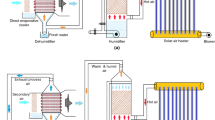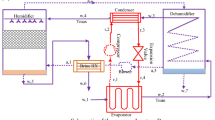Abstract
Earth atmosphere holds a vast amount of water that can be considered a reliable freshwater resource. The desiccant-based atmospheric water generator comprises a basic humidification–dehumidification (HDH) system that uses a liquid desiccant solution instead of saline water and a desiccant-based air dryer. This paper focuses on the regeneration part of the desiccant-based atmospheric water generator. An experimental study is conducted on this part, which is a desiccant (lithium bromide)-heated open-air HDH cycle with brine recirculation. The system is designed and implemented in a controlled setting to investigate the effect of various system operating parameters, including desiccant-to-air mass flowrate ratio, cooling water mass flowrate, desiccant temperature, and cooling water temperature on the system performance indices. Performance is assessed based on the system freshwater recovery ratio, gain output ratio (GOR), and freshwater productivity. This study presents an innovative method by integrating humidification–dehumidification as the regeneration process within the atmospheric water generator to showcase its practicality. Results indicate an optimum desiccant-to-air mass flowrate ratio at which maximizes the system recovery ratio, productivity, and gain output ratio (GOR). Higher desiccant-to-air mass flowrate ratio and top (heating) temperatures lead to increased freshwater production rate, GOR, and freshwater recovery ratio. Lower bottom (cooling water) temperatures and higher cooling water flowrate enhance the system's performance.















Similar content being viewed by others
Abbreviations
- DH:
-
Desiccant-heated
- GOR:
-
Gain output ratio
- HDH:
-
Humidification–dehumidification
- HME:
-
Heat and mass exchange
- MED:
-
Multiple effect desalination
- MENA:
-
Middle East and North Africa
- PVC:
-
Polyvinyl chloride
- h fg :
-
Latent heat of vaporization (kJ kg−1)
- \(\dot{m}\) :
-
Mass flowrate (kg s−1)
- MR:
-
Mass flowrate ratio for desiccant to air
- n :
-
Number
- \(\dot{Q}\) :
-
Rate of heat input (kW)
- R:
-
Result
- RR:
-
Recovery ratio (%)
- t :
-
Time (s)
- T :
-
Temperature (°C)
- T cold :
-
Cooling water operating temperature—bottom temperature
- T hot :
-
Hot desiccant temperature—top temperature
- x :
-
Independent variable
- \(\delta\) :
-
Uncertainty or variation
- ∂:
-
Partial derivative
- a :
-
Air
- ch:
-
Chiller
- cw:
-
Cooling water
- d :
-
Dry
- db:
-
Dry-bulb
- deh:
-
Dehumidifier
- est:
-
Estimated
- exp:
-
Experimental
- fp:
-
Freshwater production
- hum:
-
Humidifier
- ht:
-
Heater
- in:
-
Inlet
- out:
-
Outlet
- R :
-
Results
- s :
-
Desiccant
- tank:
-
Desiccant tank
- wb:
-
Wet-bulb
References
Alirahmi, S.M.; Mousavi, S.B.; Razmi, A.R.; Ahmadi, P.: A comprehensive techno-economic analysis and multi-criteria optimization of a compressed air energy storage (CAES) hybridized with solar and desalination units. Energy Convers. Manag. 236, 114053 (2021). https://doi.org/10.1016/j.enconman.2021.114053
Ziyaei, M.; Jalili, M.; Chitsaz, A.; Nazari, M.A.: Dynamic simulation and life cycle cost analysis of a MSF desalination system driven by solar parabolic trough collectors using TRNSYS software: a comparative study in different world regions. Energy Convers. Manag. 243, 114412 (2021). https://doi.org/10.1016/j.enconman.2021.114412
Tlili, I.; Alkanhal, T.A.; Othman, M.; Dara, R.N.; Shafee, A.: Water management and desalination in KSA view 2030: case study of solar humidification and dehumidification system. J. Therm. Anal. Calorim. 139, 3745–3756 (2020). https://doi.org/10.1007/s10973-019-08700-z
Zhang, Y.; Palomba, V.; Frazzica, A.: Understanding the effect of materials, design criteria and operational parameters on the adsorption desalination performance—a review. Energy Convers. Manag. 269, 116072 (2022). https://doi.org/10.1016/j.enconman.2022.116072
Liang, Y.; Xu, J.; Luo, X.; Chen, J.; Yang, Z.; Chen, Y.: Cradle-to-grave life cycle assessment of membrane distillation systems for sustainable seawater desalination. Energy Convers. Manag. 266, 115740 (2022). https://doi.org/10.1016/j.enconman.2022.115740
Liu, T.K.; Ye, J.-A.; Sheu, H.-Y.: Exploring the social acceptability for the desalination plant project: perceptions from the stakeholders. Desalination 532, 115757 (2022). https://doi.org/10.1016/j.desal.2022.115757
Pistocchi, A.; Bleninger, T.; Breyer, C.; Caldera, U.; Dorati, C.; Ganora, D., et al.: Can seawater desalination be a win–win fix to our water cycle? Water Res. 182, 115906 (2020). https://doi.org/10.1016/j.watres.2020.115906
Wang, W.; Shi, Y.; Zhang, C.; Hong, S.; Shi, L.; Chang, J., et al.: Simultaneous production of fresh water and electricity via multistage solar photovoltaic membrane distillation. Nat. Commun. 10, 3012 (2019). https://doi.org/10.1038/s41467-019-10817-6
Elhashimi, M.A.; Gee, M.; Abbasi, B.: Unconventional desalination: the use of cyclone separators in HDH desalination to achieve zero liquid discharge. Desalination 539, 115932 (2022). https://doi.org/10.1016/j.desal.2022.115932
Shalaby, S.M.; Sharshir, S.W.; Kabeel, A.E.; Kandeal, A.W.; Abosheiasha, H.F.; Abdelgaied, M., et al.: Reverse osmosis desalination systems powered by solar energy: preheating techniques and brine disposal challenges—a detailed review. Energy Convers. Manag. 251, 114971 (2022). https://doi.org/10.1016/j.enconman.2021.114971
Mohammed, R.H.; Ibrahim, M.M.; Abu-Heiba, A.: Exergoeconomic and multi-objective optimization analyses of an organic Rankine cycle integrated with multi-effect desalination for electricity, cooling, heating power, and freshwater production. Energy Convers. Manag. 231, 113826 (2021). https://doi.org/10.1016/j.enconman.2021.113826
Elbassoussi, M.H.; Mohammed, R.H.; Zubair, S.M.: Thermoeconomic assessment of an adsorption cooling/desalination cycle coupled with a water-heated humidification-dehumidification desalination unit. Energy Convers. Manag. 223, 113270 (2020). https://doi.org/10.1016/j.enconman.2020.113270
Elbassoussi, M.H.; Antar, M.A.; Zubair, S.M.: Hybridization of a triple-effect absorption heat pump with a humidification-dehumidification desalination unit: thermodynamic and economic investigation. Energy Convers. Manag. 233, 113879 (2021). https://doi.org/10.1016/j.enconman.2021.113879
Lienhard, J.; Antar, M.A.; Bilton, A.; Blanco, J.; Zaragoza, G.: Solar desalination. Annu. Rev. Heat Transf. 15, 277–347 (2012). https://doi.org/10.1615/AnnualRevHeatTransfer.2012004659
Sharqawy, M.H.; Antar, M.A.; Zubair, S.M.; Elbashir, A.M.: Optimum thermal design of humidification dehumidification desalination systems. Desalination 349, 10–21 (2014). https://doi.org/10.1016/j.desal.2014.06.016
Saeed, A.; Antar, M.A.; Sharqawy, M.H.; Badr, H.M.: CFD modeling of humidification dehumidification distillation process. Desalination 395, 46–56 (2016). https://doi.org/10.1016/j.desal.2016.03.011
Zubair, M.I.; Al-Sulaiman, F.A.; Antar, M.A.; Al-Dini, S.A.; Ibrahim, N.I.: Performance and cost assessment of solar driven humidification dehumidification desalination system. Energy Convers. Manag. 132, 28–39 (2017). https://doi.org/10.1016/j.enconman.2016.10.005
Narayan, G.P.; Chehayeb, K.M.; McGovern, R.K.; Thiel, G.P.; Zubair, S.M.; Lienhard, V.J.H.: Thermodynamic balancing of the humidification dehumidification desalination system by mass extraction and injection. Int. J. Heat Mass Transf. 57, 756–770 (2013). https://doi.org/10.1016/j.ijheatmasstransfer.2012.10.068
McGovern, R.K.; Thiel, G.P.; Narayan, G.P.; Zubair, S.M.; Lienhard, V.J.H.: Performance limits of zero and single extraction humidification-dehumidification desalination systems. Appl. Energy 102, 1081–1090 (2013). https://doi.org/10.1016/j.apenergy.2012.06.025
Xu, H.; Jiang, S.; Xie, M.X.; Jia, T.; Dai, Y.J.: Technical improvements and perspectives on humidification-dehumidification desalination—a review. Desalination 541, 116029 (2022). https://doi.org/10.1016/j.desal.2022.116029
Ahmed, M.A.; Qasem, N.A.A.; Zubair, S.M.; Gandhidasan, P.; Bahaidarah, H.M.: Thermodynamic balancing of the regeneration process in a novel liquid desiccant cooling/desalination system. Energy Convers. Manag. 176, 86–98 (2018). https://doi.org/10.1016/j.enconman.2018.09.012
Qasem, N.A.A.; Zubair, S.M.: Performance evaluation of a novel hybrid humidification-dehumidification (air-heated) system with an adsorption desalination system. Desalination 461, 37–54 (2019). https://doi.org/10.1016/j.desal.2019.03.011
Lawal, D.; Antar, M.; Khalifa, A.; Zubair, S.; Al-Sulaiman, F.: Humidification-dehumidification desalination system operated by a heat pump. Energy Convers. Manag. 161, 128–140 (2018). https://doi.org/10.1016/j.enconman.2018.01.067
Santosh, R.; Yoo, C.H.; Kim, Y.-D.: Performance evaluation and optimization of humidification–dehumidification desalination system for low-grade waste heat energy applications. Desalination 526, 115516 (2022). https://doi.org/10.1016/j.desal.2021.115516
Negharchi, S.M.; Najafi, A.; Nejad, A.A.; Ghadimi, N.: Determination of the optimal model for solar humidification dehumidification desalination cycle with extraction and injection. Desalination 506, 114984 (2021). https://doi.org/10.1016/j.desal.2021.114984
Zubair, S.M.; Antar, M.A.; Elmutasim, S.M.; Lawal, D.U.: Performance evaluation of humidification-dehumidification (HDH) desalination systems with and without heat recovery options: an experimental and theoretical investigation. Desalination 436, 161–175 (2018). https://doi.org/10.1016/j.desal.2018.02.018
Ghalavand, A.; Hatamipour, M.S.; Ghalavand, Y.: Performance evaluation of a multi-stage humidification compression with heat recovery based on mathematical modeling. Desalination 515, 115189 (2021). https://doi.org/10.1016/j.desal.2021.115189
Narayan, G.P.; John, M.G.; Zubair, S.M.; V JHL,: Thermal design of the humidification dehumidification desalination system: an experimental investigation. Int. J. Heat Mass Transf. 58, 740–748 (2013). https://doi.org/10.1016/j.ijheatmasstransfer.2012.11.035
Sharqawy, M.H.; Al-Shalawi, I.; Antar, M.A.; Zubair, S.M.: Experimental investigation of packed-bed cross-flow humidifier. Appl. Therm. Eng. 117, 584–590 (2017). https://doi.org/10.1016/j.applthermaleng.2017.02.061
Aburub, A.J.; Aliyu, M.; Lawal, D.; Antar, M.A.: Experimental investigations of a cross-flow humidification dehumidification desalination system. Int. Water Technol. J. 7, 198–208 (2017)
Aburub, A.J.; Aliyu, M.; Lawal, D.; Antar, M.A.: Experimental investigations of the performance of a cross-flow humidification-dehumidification desalination system. In: 20th Int. Water Technol. Conf. IWTC20, Hurghada (2017)
Yamalı, C.; Solmus, İ: A solar desalination system using humidification–dehumidification process: experimental study and comparison with the theoretical results. Desalination 220, 538–551 (2008). https://doi.org/10.1016/j.desal.2007.01.054
Al-Sulaiman, F.A.; Abd-Ur-Rehman, H.M.; Antar, M.A.; Munteshari, O.: Experimental investigation of a bubble column humidifier heated through solar energy. Desalin. Water Treat. 60, 58–69 (2017). https://doi.org/10.5004/dwt.2017.0086
Ahmed, M.A.; Zubair, S.M.; Abido, M.A.; Bahaidarah, H.M.: An innovative closed-air closed-desiccant HDH system to extract water from the air: a case for zero-brine discharge system. Desalination 445, 236–248 (2018). https://doi.org/10.1016/j.desal.2018.07.024
Modi, K.V.; Shukla, D.L.: Regeneration of liquid desiccant for solar air-conditioning and desalination using hybrid solar still. Energy Convers. Manag. 171, 1598–1616 (2018). https://doi.org/10.1016/j.enconman.2018.06.096
Su, B.; Han, W.; Jin, H.: An innovative solar-powered absorption refrigeration system combined with liquid desiccant dehumidification for cooling and water. Energy Convers. Manag. 153, 515–525 (2017). https://doi.org/10.1016/j.enconman.2017.10.028
Kabeel, A.E.; Abdelgaied, M.; Zakaria, Y.: Performance evaluation of a solar energy assisted hybrid desiccant air conditioner integrated with HDH desalination system. Energy Convers. Manag. 150, 382–391 (2017). https://doi.org/10.1016/j.enconman.2017.08.032
Exposed Junction Wire Thermocouples. https://ratemperaturesensors.co.uk/pfa-flat-pair--exposed-junction-wire-thermocouple-250c-1427-p.asp. Accessed 11 Oct 2023.
In-line Flow meters. https://sea.omega.com/tw/pptst/FL46300.html. Accessed 11 Oct 2023
SMART SENSOR AR836 DIGITAL ANEMOMETER. https://ronexintl.wordpress.com/2019/10/27/smart-sensor-ar836-digital-anemometer-in-bangladesh/. Accessed 11 Oct 2023
Holman, J.P.: Experimental Methods of Engineering. McGraw-Hill Book Company, New York (1971)
Kline, S.J.; McClintock, F.A.: Describing uncertainties in single sample experiments. Mech. Eng. 75, 3–8 (1953)
Lawal, D.U.; Antar, M.A.; Khalifa, A.; Zubair, S.M.; Al-Sulaiman, F.: Experımental investigation of heat pump driven humidification-dehumidification desalination system for water desalination and space conditioning. Desalination 475, 114199 (2020). https://doi.org/10.1016/j.desal.2019.114199
Liu, J.; Ren, H.; Hai, F.I.; Albdoor, A.K.; Ma, Z.: Direct contact membrane distillation for liquid desiccant regeneration and fresh water production: experimental investigation, response surface modeling and optimization. Appl. Therm. Eng. 184, 116293 (2021). https://doi.org/10.1016/j.applthermaleng.2020.116293
Zhou, J.; Wang, F.; Noor, N.; Zhang, X.: An experimental study on liquid regeneration process of a liquid desiccant air conditioning system (LDACs) based on vacuum membrane distillation. Energy 194, 116891 (2020). https://doi.org/10.1016/j.energy.2019.116891
Audah, N.; Ghaddar, N.; Ghali, K.: Optimized solar-powered liquid desiccant system to supply building fresh water and cooling needs. Appl. Energy 88, 3726–3736 (2011). https://doi.org/10.1016/j.apenergy.2011.04.028
Acknowledgements
The authors acknowledge the support provided by King Fahd University of Petroleum & Minerals through the project DUP20101.
Author information
Authors and Affiliations
Corresponding author
Rights and permissions
Springer Nature or its licensor (e.g. a society or other partner) holds exclusive rights to this article under a publishing agreement with the author(s) or other rightsholder(s); author self-archiving of the accepted manuscript version of this article is solely governed by the terms of such publishing agreement and applicable law.
About this article
Cite this article
Ahmed, M.A.M., Shamet, O., Lawal, D.U. et al. Proof of Concept of the Regeneration Part in a Novel Desiccant-Based Atmospheric Water Generator. Arab J Sci Eng 49, 2813–2829 (2024). https://doi.org/10.1007/s13369-023-08512-2
Received:
Accepted:
Published:
Issue Date:
DOI: https://doi.org/10.1007/s13369-023-08512-2




